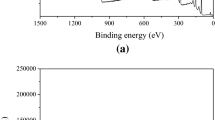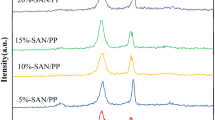Abstract
Various sectors of the industry are searching for new materials with specific requirements, providing improved properties. The study presents novel composite materials based on polylactide that have been modified with the organosilicon compound, (3-thiopropyl) polysilsesquioxane (SSQ-SH). The SSQ-SH compound is a mixture of cage structures and not fully condensed random structures. The composite materials were obtained through injection moulding. The study includes a comprehensive characterization of the new materials that analyze their functional properties, such as rheology (MFR), mechanical strength (tensile strength, Charpy impact strength), and thermal properties. SEM microscopic photos were also taken to analyze the microstructure of the samples. The addition of a 5% by-weight organosilicon compound to polylactide resulted in a significant increase in MFR by 73.8% compared to the neat polymer. The greatest improvement in impact strength was achieved for the 5% SSQ-SH/PLA composite, increasing it by 32.0 kJ/m2 compared to PLA, which represents an increase of up to 187%. The conducted research confirms the possibility of modifying the properties of the polymer by employing organosilicon compounds.
Similar content being viewed by others
Data Availability Statement
The data presented in this study are available on request from the corresponding author. The data are not publicly available: bogdan.marciniec@amu.edu.pl (B.M.), robert.przekop@amu.edu.pl (R.E.P.)
References
Madhavan Nampoothiri, K.; Nair, N. R.; John, R. P. An overview of the recent developments in polylactide (PLA) research. Bioresour. Technol. 2010, 101, 8493–8501.
Sangeetha, V.; Deka, H.; Varghese, T.; Nayak, S. State of the art and future prospectives of poly(lactic acid) based blends and composites. Polym. Compos. 2016, 39, 81–101.
Raquez, J.; Habibi, Y.; Murariu, M.; Dubois, P. Polylactide (PLA)-based nanocomposites. Prog. Polym. Sci. 2013, 38, 1504–1542.
Anderson, K.; Schreck, K.; Hillmyer, M. Toughening polylactide. Polym. Rev. 2008, 48, 85–108.
Vink, E.; Rábago, K.; Glassner, D.; Gruber, P. Applications of life cycle assessment to NatureWorks™ polylactide (PLA) production. Polym. Degrad. Stabil. 2003, 80, 403–419.
Hajighasemi, M.; Nocek, B.; Tchigvintsev, A.; Brown, G.; Flick, R.; Xu, X.; Cui, H.; Hai, T.; Joachimiak, A.; Golyshin, P.; Savchenko, A.; Edward, E.; Yakunin, A. Biochemical and structural insights into enzymatic depolymerization of polylactic acid and other polyesters by microbial carboxylesterases. Biomacromolecules 2016, 17, 2027–2023.
Farah, S.; Anderson, D.; Langer, R. Physical and mechanical properties of PLA, and their functions in widespread applications—a comprehensive review. Adv. Drug Deliv. Rev. 2019, 107, 367–392.
Ahmed, J.; Zhang, J.; Song, Z.; Varshney, S. Thermal properties of polylactides: effect of molecular mass and nature of lactide isomer. Therm. Anal. Calorim. 2009, 95, 957–964.
Cheng, Y.; Deng, S.; Chen, P.; Ruan, R. Polylactic acid (PLA) synthesis and modifications: a review. Front. Chem. China 2009, 4, 259–264.
Wang, C.; Smith, L.; Zhang, W.; Li, M.; Wang, G.; Shi, S.; Cheng, H.; Zhang, S. Reinforcement of polylactic acid for fused deposition modeling process with nano particles treated bamboo powder. Polymers 2019, 11, 1146.
Bouzouita, A. Elaboration of polylactide-based materials for automotive application: study of structure-process-properties interactions, Doctoral dissertation, Université de Valenciennes et du Hainaut-Cambresis; Université de Mons), 2016.
Auras, R.; Bruce, H.; Susan, S. An overview of polylactides as packaging materials. Macromol. Biosci. 2004, 4, 835–864.
Avinc, O.; Akbar, K. Overview of poly (lactic acid) (PLA) fibre: Part I: production, properties, performance, environmental impact, and end-use applications of poly(lactic acid) fibres. Fibre Chem. 2009, 41, 391–401.
Bourbigot, S.; Gaëlle, F. Flame retardancy of polylactide: an overview. Polym. Chem. 2010, 1, 1413–1422.
Atiwesh, G.; Mikhael, A.; Parrish, C.; Banoub, J.; Le, T. Environmental impact of bioplastic use: a review. Heiiyon 2021, 7, e07918.
Bergström, J.; Hayman, D. An overview of mechanical properties and material modeling of polylactide (PLA) for medical applications. Ann. Biomed. Eng. 2016, 44, 330–340.
Kozera, R.; Przybyszewski, B.; Krawczyk, Z.; Boczkowska, A.; Sztorch, B.; Przekop, R.; Barbucha, R.; Tański, M.; Garcia-Casas, X.; Borras, A. A. Hydrophobic and anti-icing behavior of UV-laser-treated polyester resin-based gelcoats. Processes 2020, 8, 1642.
Mituta, K.; Duszczak, J.; Rzonsowska, M.; Żak, P.; Dudziec, B. Polysiloxanes grafted with mono(alkenyl)silsesquioxanes—particular concept for their connection. Materials 2020, 13, 4784.
Januszewski, R.; Kownacki, I.; Maciejewski, H.; Marciniec, B. Transition metal-catalyzed hydrosilylation of polybutadiene—the effect of substituents at silicon on efficiency of silylfunctionalization process. J. Catal. 2019, 371, 27–34.
Brząkalski, D.; Przekop, R.; Sztorch, B.; Jakubowska, P.; Jałbrzykowski, M.; Marciniec, B. Silsesquioxane derivatives as functional additives for preparation of polyethylene-based composites: a case of trisilanol melt-condensation. Polymers 2020, 12, 2269.
Sirin, H.; Kodal, M.; Ozkoc, G. The influence of POSS type on the properties of PLA. Polym. Compos. 2014, 37, 497–1506.
Chen, Y.; Liu, S.; Zhou, Y.; Zeng, G.; Liu, W. Biodegradable PLA-based composites modified by POSS particles. Polym. Plast. Tech. Mat. 2020, 59, 998–1009.
Yazdaninia, A.; Khonakdar, H.; Jafari, S.; Asadi, V. Influence of trifluoropropyl-POSS nanoparticles on the microstructure, rheological, thermal and thermomechanical properties of PLA. RSC Adv. 2016, 6, 37149–37159.
Herc, A.; Lewiński, P.; Kaźmierski, S.; Bojda, J.; Kowalewska, A. Hybrid SC-polylactide/poly(silsesquioxane) blends of improved thermal stability. Thermochim. Acta 2020, 178592.
Sztorch, B.; Brząkalski, D.; Gtowacka, J.; Pakuta, D.; Frydrych, M.; Przekop, R. Trimming flow, plasticity, and mechanical properties by cubic silsesquioxane chemistry. Sci. Rep. 2023, 13, 14156.
Brząkalski, D.; Sztorch, B.; Frydrych, M.; Pakuła, D.; Dydek, K.; Kozera, R.; Boczkowska, A.; Marciniec, B.; Przekop, R. Limonene derivative of spherosilicate as a polylactide modifier for lions in 3D printing technology. Molecules 2020, 25, 5882.
Pakuła, D.; Przekop, R.; Brząkalski, D.; Frydrych, M.; Sztorch, B.; Marciniec, B. Sulfur-containing silsesquioxane derivatives obtained by the thiol-ene reaction: synthesis and thermal degradation. ChemPlusChem 2022, 87, e202200099.
Benedetti, A.; Fagherazzi, G.; Enzo S.; Battagliarin, M. A profile-fitting procedure for analysis of broadened X-ray diffraction peaks. II. Application and discussion of the methodology. J. Appl. Crystallogr. 1988, 21, 543–549.
Jian, Z.; Hejing, W. The physical meanings of 5 basic parameters for an X-ray diffraction peak and their application. Chin. J. Geochem. 2003, 22, 38–44.
Sun, Z.; Wang, L.; Zhou, J.; Fan, X.; Xie, H.; Zhang, H.; Zhang, G.; Shi, X. Influence of polylactide (PLA) stereocomplexation on the microstructure of pla/pbs blends and the cell morphology of their microcellular foams. Polymers 2020, 12, 2362.
Safandowska, M.; Rozanski, A. Ring-banded spherulites in polylactide and its blends. Polym. Test. 2021, 100, 107230.
Kovalcik, A.; Pérez-Camargo, R.; Fürst, C.; Kucharczyk, P.; Müller, A. Nucleating efficiency and thermal stability of industrial non-purified lignins and ultrafine talc in poly(lactic acid)(PLA). Polym. Degrad. Stabil. 2017, 142, 244–254.
Wang, R.; Wang, S.; Zhang, Y. Morphology, rheological behavior, and thermal stability of PLA/PBSA/POSS composites. J. Appl. Polym. Sci. 2009, 113, 3095–3102.
Liu, Z.; Hu, D.; Huang, L.; Li, W.; Tian, J.; Lu, L.; Zhou, C. Simultaneous improvement in toughness, strength and biocompatibility of poly(lactic acid) with polyhedral oligomeric silsesquioxane. J. Chem. Eng. 2018, 346, 649–661.
Cao, X.; Mohamed, A.; Gordon, S.; Willett, J.; Sessa, D. DSC study of biodegradable poly(lactic acid) and poly(hydroxy ester ether) blends. Thermochim. Acta 2003, 406(1–2), 115–127.
Alamri, H.; El-Hadi, A.; Al-Qahtani, S.; Assaedi, H.; Alotaibi, A. Role of lubricant with a plasticizer to change the glass transition temperature as a result improving the mechanical properties of poly(lactic acid) PLLA. Mater. Res. Express 2020, 7, 025306.
Li, D.; Jiang, Y.; Lv, S.; Liu, X.; Gu, J.; Chen, Q.; Zhang, Y. Preparation of plasticized poly (lactic acid) and its influence on the properties of composite materials. PLoS One 2018, 1, 0193520.
Przekop, R.; Gabriel, E.; Pakuta, D.; Sztorch, B. Liquid for fused deposition modeling technique (L-FDM)—a revolution in application chemicals to 3D printing technology: color and elements. Appl. Sci. 2023, 13, 7393.
Herc, A.; Bojda, J.; Nowacka, M.; Lewiański, P.; Maniukiewicz, W.; Piorkowska, E.; Kowalewska, A. Crystallization, structure and properties of polylactide/ladder poly(silsesquioxane) blends. Polymer 2020, 201, 122563.
Wang, L.; Gramlich, W. M.; Gardner, D. J. Improving the impact strength of poly(lactic acid) (PLA) in fused layer modeling (FLM). Polymer 2017, 114, 242–248.
Yang, G.; Su, J.; Su, R.; Zhang, Q.; Fu, Q.; Na, B. Toughening of poly(l-lactic acid) by annealing: the effect of crystal morphologies and modifications. J. Macrol. Sci. B 2011, 51, 184–196.
Sirin, H.; Kodal, M.; Ozkoc, G. The influence of POSS type on the properties of PLA. Polym. Compos. 2014, 37, 1497–1506.
Evans, A. The strength of brittle materials containing second phase dispersions. Phil. Mag. 1972, 26, 1327–1344.
Safandowska, M.; Rozanski, A.; Galeski, A. Plasticization of polylactide after solidification: an effectiveness and utilization for correct interpretation of thermal properties. Polymers 2020, 12, 561.
Meng, X.; Nguyen, N. A.; Tekinalp, H.; Lara-Curzio, E.; Ozcan, S. Supertough PLA-silane nanohybrids by in situ condensation and grafting. ACS Sustain. Chem. Eng. 2017, 6, 1289–1298.
Acknowledgments
This work was financially supported by the Smart Growth Operational Programme (No. POIR.04.02.00-00-D003/20-00); European Funds (No. RPWP.01.01.00-30-0004/18) and Ministry of Science and Higher Education (No. 21/529535/SPUB/SP/2022).
Author information
Authors and Affiliations
Corresponding authors
Ethics declarations
The authors declare no interest conflict.
Additional information
Patents
The results of this publication have been patented with Polish patent application no. P.446764, 17.11.2023r.
Rights and permissions
About this article
Cite this article
Pakuła, D., Sztorch, B., Romańczuk-Ruszuk, E. et al. High Impact Polylactide Based on Organosilicon Nucleation Agent. Chin J Polym Sci (2024). https://doi.org/10.1007/s10118-024-3095-7
Received:
Accepted:
Published:
DOI: https://doi.org/10.1007/s10118-024-3095-7




